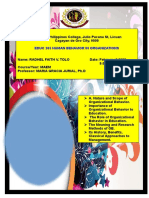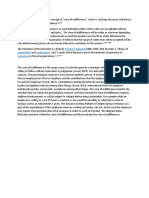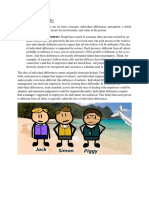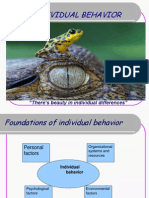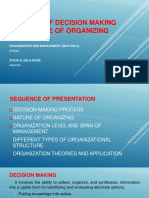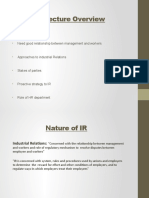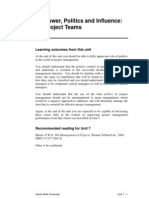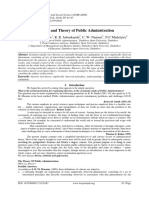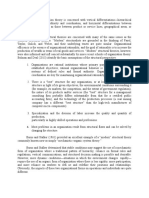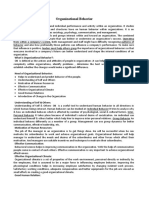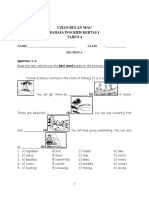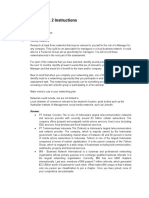Dynamics of Organizational Behavior
CONCEPT OF ORGANIZATIONAL BEHAVIOUR
ORGANISATION:
An organization is a group of people working together in a formally organized way to Achieve a
common objective. The main objective is profit maximization. Features of an organization:
Group of people
Formally organized people/structure
Co-ordination among people
Rationality
Purposefully created to achieve a common goal
BEHAVIOUR:
It is how a person behaves. It is an observable and measurable activity of human
being.
ORGANISATIONAL BEHAVIOUR
Definition: - Stephen P Robbins
t is a field of study that investigates the impact that individuals, groups , structures
have on
behavior within the organization, for the purpose of applying such knowledge
towards
Improving organizational effectiveness‘.
Hence based on the definition we can say that:
OB is a field of study
It studies individuals, groups and structures
It applies the knowledge to improve organizational effectiveness.
Therefore Organization Behavior is concerned with two aspects:-
o How people behave in an organization?
o How their behavior does affect their performance?
Definition–Keith Davis
-Organizational Behaviors is the study and application of knowledge about how
people act with in the organization.
Definition: - Stephen P Robbins
1
�-It is a field of study that investigates the impact that individuals, groups ,
structures have on behavior within the organization, for the purpose of applying
such knowledge towards improving organizational effectiveness‘.
Hence based on the definition we can say that:
OB is a field of study
It studies individuals, groups and structures
It applies the knowledge to improve organizational effectiveness. There fore
Organization Behaviors is concerned with two aspects:-
How people behave in an organization?
How their behavior does affect their performance?
Organizational Behaviors is the study and application of knowledge about how
people act with in the organization‖. Definition – Keith Davis
KEY ELEMENTS OF ORGANISATIONAL BEHAVIOUR
KEY ELEMENTS OF OB
PEOPLEL STRUCTURE TECHNOLOGY ENVIRONMENT
People
Structure
Technology
Environment
4OB studies the following aspects
People: Individuals & Groups
Structure: Official Relationship
Technology: Physical, Economic resources
Environment: Political, Legal an Nature
NATURE OF OB
2
�1. It is just a field of study and not a discipline:
OB is accepted science with theoretical foundation and it serves as a base of research. It is a
recent field of study which has its origin from management. It is broad based and inter disciplinary
in nature. Hence it is not a discipline but a field of study.
2. It is interdisciplinary in nature: It is broad based and inter disciplinary in nature because it has
its origin from subjects like psychology, sociology, anthropology, medical sciences, political science
etc.,
3. It is normative science and value centered :( cause and effect application):
A positive science analyses only the cause and effect relationship but a normative
Science analyses the cause and effect and also its application to achieve organizational results.
It is also value centered as it analyses what is acceptable to employees based on the values they
have.
4. It is applied science: The principles of OB are proven and can be applied to solve
organizational problems.
5. It has humanistic approach: OB considers human feelings , their values and attitudes and
considers that human beings are not machines and they too be cared for.
6. It has optimistic approach: It has positive approach and views that the employees well
contribute positively to achieve the objectives of the organization. It is directed towards
achievement of organizational objectives: Organizational objectives are given more importance
then individual objectives.
7. It has rational approach: It believes that there is a reason being every behavior of man and
works on the same formula.
8. It is developmental in nature: It aims at the development of the its employees and help them
to attain their goals.
9. It is part of management science: OB is a study that has emerged form the discipline of
management .Hence is a part of management science.
10. It is both science and art: OB is both science and art. It is science because, like science OB is
also a systematic body of knowledge, its analyses is also consistent in nature, it can be
systematically explained and critically evaluated, the analyses are based on the findings of
management theorists. It s art because it is related to bringing desired result, it is application of
skills like leadership skills, managerial skills, training skills etc.,
11. It has total systems approach: It takes all variables in consideration. It studies
individuals and groups in formal and informal relations in organizations.
FOUNDATIONS OF OB / BASIC CONCEPT OF OB
1. Individual differences exists: Every individual has a unique personality, which is
stable in nature. Hence each person is different from the other based on his
3
�physiological, psychological and social characteristics. Three aspects should take care while
studying human behavior:
2. Behaviors is caused: Behaviors is what a person does and it is cause and effect relationship. It
means that there is a reason behind every single behavior on any individual. Hence the cause
should be evaluated by the manager in an organization.
3. Behaviors is complex: Though OB believe that behavior is caused, yet it is very
difficult to understand human behavior.
4. Value of a person: Human value is given importance. It means one should be treated with
respect and dignity. Values and attitudes should be considered. Men at workplace should be
considered
5. Whole person concept: The concept states that a individual employed by the organization is
cannot be separate form his personal life aspects .Though an organization employs a person‘s skill
& brain in his organization, yet it is a fact that an individual cannot be separated from his home
life and work life.
6. Role of a person
A role is a pattern of actions expected of a person in activities involving others. Each
Individual plays different roles in his life time.( Parent, son , Friend , Spouse, team
member, supervisor, follower, advisor, consumer, investor etc., ).Hence it becomes
necessary for him to understand the role clearly and act accordingly.
7. Difference between individual behavior and group behavior:
Individual behavior may be good but group behavior may be bad .Group behavior may be good
but Individual behavior may be bad. As Individual behavior may vary form group behavior, human
behavior should be studied in both the aspects
SCOPE OF OB
OB can be studied in three different levels: -
1. Individual-
Intra Individual- Understanding human behavior i.e. how and why an
individual behaves and to understand the factors affecting human behavior
Inter Individual- To understand the working relationships, role analysis and
transaction analysis of individual with others.
2. Group
Intra Group – understand the group pressure on individuals, influence of group norms on
individuals, communication process in organization.
Inter Group – Relationship between groups, achievement of group objectives and group
objectives.,
3.Organization:
4
� Intra- Organization- use of human power in organizations, leadership qualities,
communication in organization.
Inter –Organization- organization change, external relationships, development standards
and concepts for future, Scientific and rational approach to Human Behaviors.
Disciplines contributing to Organizational Behaviors
1. Sociology: It is the study of people in relation to their fellow human beings, The
field of sociology has made valuable contributions in the study of group of
individuals, group dynamics, formation of groups, communication, formal and
informal organizations etc.,
2. Anthropology : It is the study of societies to learn about human beings and their
activities. It helps us to understand values, attitudes and behavior between
people in different regions and organizations.
3. Economics: It is the science that deals with the production, distribution, and
consumption of goods and services, or the material welfare of humankind.
4. History: It is the study of the origin and evolution of man kind. It help us to
understand the behavior of people and their origins
5. Political science: It helps us to study the current political and legal scenario and
the role of the study of human behavior under the current situations
ORGANISATIONAL BEHAVIOURAL MODELS
In management, the focus is on the study of the five organizational behavior
models:
o Autocratic Model
o Custodial Model
o Supportive Model
o Collegial Model
o System Mode
1. Autocratic model
This model has its roots in the historical past, and definitely became a most prominent model of
the industrial revolution of 1800 and 1900s. It gives the owners and manager‘s power to dictate
and form decisions while making employees obey their orders. The model asserts that employees
need to be instructed and motivated to perform while managers do all the thinking. The whole
process is formalized with the managers and authority power has the right to give command to
the people, ―You do this or else…‖, is
a general dictatorship command. As Newstrom suggests, ―the psychological result of the
employees is dependence on their boss, whose power to ―hire, fire and perspire‖ is almost
absolute. Employers receive less wages as they are less skilled and their performance is also
minimum, which they do it rather reluctantly as they have to satisfy the needs of their families
5
�and themselves. But there are some exceptions as many employees do give higher performance
because either they would like to achieve or have a close association with their boss, or either they
have been promised a good reward, but overall their performance is minimum.
The theory of X assumption of McGregor states employers do not take responsibility and
managers have to supervise over their work to obtain desired results. This model can also be
compared to the Likert system in which use of punishment, force, fear or threats sometimes are
used as means to get the results from the employees.
Custodial Model
Now the time came when managers began to think the security of the employees is
imperative- it could be either social as well economic security. Now managers have
begun to study about their employees needs, they found out that though in the
autocratic setup employees does not talk back yet they have many things to say but
incapability to speak result in frustrations, insecurity, and aggressive behavior towards their boss.
Since they are not able to display their feelings, they would vent these feelings on their family and
neighbors. This causes suffering to the entire community and relationships and this often results in
bad performance. Newstrom gave the example of a wood processing plant where the employees
were treated very cruelly even to the extent of physical abuse. Since workers were not able to
strike back directly they show their aggression by destroying the good sheets of veneer destroying
the supervisor‘s credibility.
Employers now had begun to think of the ways to develop better relations with the employees and
to keep them satisfied and motivated. In 1890 and 1900 many
Companies started the welfare programs for the employees which began later to be known as
paternalism. In the 1930s, these welfare programs evolved in many fringe benefits to provide
security to the employees which resulted in the development of the Custodial model of
organizational behavior.
A successful custodial approach depends on providing economic security which many
companies are now offering as high pay scale, remunerations in the form of health benefits,
corporate cars, financial packaging and many other forms of incentives. These incentives increase
the employees‘ satisfaction level and help them to achieve competitive advantage. To avoid
layoffs employers also tries to ―retain employees, reduce overtime, freeze hiring, encourage both
the job transfers and relocations, provide early retirement incentives, and reduce subcontracting
to adjust to slowdowns especially in the information technology‖. (Newstrom, p.32)
The custodial approach induces employees now to show their dependency and loyalty towards
the company and not to the boss or managers or supervisors. The employees in this environment
are more psychologically contended and preoccupied with their rewards but it is not necessary
they would be strongly motivated to give the performance. The studies show that though it has
been the best way to make them happy employee but not productive employee, so the question
6
�still remains what should be the better way? But overall this step had been a stepping stone for
the creation and development of the next step.
Supportive Model
Unlike the two previous approaches, the supportive model emphasis on motivated and
aspiring leader. There is no space for any control or authoritative power in this model or on the
incentives or reward schemes but it is simply based on motivating staff through the
establishment of the manager and employee relationship and the treatment that is given to
employees on daily basis.
Quite contrarily to the autocratic mode, it states that employees are self-motivated and can
generate value that goes beyond their day to day role or activity. But how the employees get self
–motivated? That‘s through creating a positive work place where they are encouraged to give
their ideas and there is some kind of ―buy -in‖ in the organizational behavior setup and the
direction that it takes. One of the key aspects of the supportive model has been studies
conducted at the Hawthorne Plant of Electric in the 1920s and 1930s. The study was led by Elton
Mayo and F.J Roethlisberger to implore on the human behavior at work by implementing and
placing keen insight on the sociological, psychological perspective in the industrial setup. They
came up to a conclusion that a single organization is a social system and a worker is an important
component in the system. They found that worker is not a tool that can be used in any way but
has its own behavior and personality and needs to be understood. They suggested that
understanding of group dynamism including the application of supportive supervision is
imperative to make workers contribute and be supportive.
Through the leadership organizations give the space and climate for the employees to develop,
form their own thinking and take an initiative. They would take responsibility and improve
themselves. Managers are oriented towards supporting the employees to give performances and
not just support them through employee benefits as done in custodial approach. The supportive
model is being widely accepted chiefly in the developed nations where the needs of the
employees are different as it fulfills many of the employees emerging needs. This approach is less
successful in the developing nations where the social and economic need of the working class is
different. In short, in the supportive model money is not which retain the satisfaction of the
employees but it is a part of the organization‘s life that has been put to the use and makes other
people feel wanted.
The Collegial Model
In this scheme, the structure of an organization is developed in a way that there is no boss nor
subordinates, but all are colleagues who have to work as a team. Each one of the employees has
to participate and work in coordination with each other to achieve the target rate. No one is
7
�worried about his status or a job title. Manager‘s role is here like a coach whose function is to
guide the team to perform and generate positive and motivating work environment, instead of
focusing on his own personal growth. The team requires adopting new approaches, research and
development and new technologies to better their performance.
We can also say collegial model is an extension of the supportive model. The success of the
collegial model depends on the management‘s ability to foster the feeling of partnership
between the employees. This makes the employees feel important and needed. They also feel
that managers are not just mere supervisors but are also giving their equal contribution to the
team. To make the collegial model success many organizations have abolished the use of bosses
and subordinates during working, as these terms create the distance between the managers and
subordinates. While some of the organizations have abolished the system of allotting reserved
space for executives. Now any employee can park their vehicle in the common parking space,
which increases their convenience and makes them more comfortable.
The manager is oriented towards the team performance while each employee is responsible for
his task and towards each other. They are more disciplined and work as per the standards set by
the team. In this setup employees feel fulfilled as their contribution is accepted and well
received.
The System Model
The most emerging model of the today‘s corporate era is the system model. This model emerged
from the rigorous research to attain the higher level of meaning at work. Today‘s employees need
more than salary and security from their job, they need the hours they are putting towards the
organization is giving them some value and meaning. To add to it, they need the work
that is ethical, respectful, integrated with trust and integrity and gives a space to develop a
community feeling among the co- workers.
The three levels are individual level, group or team level, and organizational level. At all these
levels OB analyses the behavior of people on how, why, and what causes their behavior in
organizational settings.
Individual Level
This is the first level of OB analysis. At the individual level, organizational behavior studies the
behavior of an individual person such as his/her attitudes, motivation, perception, personality,
values, ethics, satisfaction, and other personal traits.
The concept of psychology plays important role in the individual-level analysis. The individuals
working in the organization are the very existence of the organization. Each individual’s behavior
is different from others, as it is natural, and some are affected by social, cultural, and other social
variables.
8
�A manager using his psychology, knowledge, and experience should carefully study the individual
traits and characteristics of his individual employees. Understanding these attributes helps
managers to come up with ideas to develop better and more positive approaches to
organizational systems.
Group Level
The organization also consists of different groups and teams. The group-level analysis of OB
studies the behavior of people at the group level, how groups work, why they interact in group
work, collaboration, group decisions, etc.
A group is a people who come together to reach some common goals. They can be small or large
and formal or informal. In a group people work together, one’s actions affect others, they are
dependent on each other, and the goal is achieved through collective effort.
Sociology, social psychology, and anthropology play an important role in studying at this level. In
addition, here OB analyses group dynamics, organizational conflicts, politics, communication, etc.
Organizational Level
At this last level organizational behavior analyses how the organization works. It mainly studies
how people interact with organizational structure, how the organization with them, and how the
external environment forces interact with the organization.
Its major variables such as work environment, organizational structure, culture, change, politics,
and environment within and outside of the organization. In fact, it is the study of how to manage
individuals, groups, or teams effectively in the organization. Sociology, anthropology, and political
science are the major disciplines contributing to this level.
The study organizational level helps managers to understand the performance of individuals and
groups and how they are contributing to the organization. By getting this, a manager can develop
suitable plans, policies, motivation programs, design jobs, and manage change, etc. in order to
run the organization smoothly.
1. Input: The input provides stimulus to OB system. It consists of various variables at individual,
group and organization level. They can be:
Individual variables: It relates to individual differences in employees. It is person specific.
They can be personal characteristics (i.e. age, gender, marital status). The personality (the
way how an individual reacts and interacts with others), the values and attitudes.
Group Variables: A group consists of two or more individuals working for a particular
objective. Group variables are concerned with role, status, norms, size, composition and
cohesiveness.
Organization System Variable: It is concerned with the structure, and working culture of
an organization.
2. Processing: It is one of the aspect of OB system. It is concerned with adding value to the input.
The processing of OB system at various levels are:
9
�Individual Level Processing
Perception: It is concerned with giving meaning to stimulus. The perception of an
individual is based on what reality is not, what reality exists.
Learning: It refers to permanent change in behavior that occurs as a result of information
and experience.
Motivation: It is stimulation of energies with intensity, direction and persistence of efforts
to achieve goals.
Decision Making: It is related to selecting the best alternative among the available
alternatives.
Group Level Processing
Communication: It is transmission of information and understanding for meaningful
purpose.
Leadership: It is the ability to influence a group towards achievement of goals.
Power and Politics: It refers to the capacity of influencing the behavior of others.
Conflict: It consist of all kinds of opposition and antagonistic interaction between different
individuals.
Team work: It is directed for synergistic effect.
Organization System Level Processing
HR Policies and Practices: It is concerned with management, practices of job design, analysis,
recruitment, selection, socialization, training, development, performance appraisal.
Organizational Development: It is the process of managing planned change through behavioral
intervention.
ii) Output: Output of the OB system are the behavioral consequences which are dependent
variables and are affected by the inputs and processing mechanism. It consists of:
1. Job Satisfaction: It refers to an individual attitude towards jobs. The satisfied employee
tends to be more productive.
2. Organizational Citizenship: It refers to employees feeling to be a part of organization and
provide performance beyond expectations.
3. High Productivity: It refers to high loyalty and performance by employees by minimizing
absenteeism and conflicts.
4. Low Turnover: It refers to minimum level of complaints from customers.
5. iv) Feedback: It provides information to redesign OB inputs and processing to achieve the
desired behavioral consequences in the system.
10
� 6.
7. Level of Analysis of Organizational Behavior (OB)
8. Organizational behavior offers several ideas to management as to how human factor should
be properly emphasized to achieve organizational goals and objectives. Human factor is not
merely an instrument in the organization but the very core organizational existence.
In the system model, the expectations of the managers are much more than getting the work
done by the employees. The managers have to show their emotional side, be more
compassionate and caring towards their team and they must be sensitive towards the needs of
the diverse workforce. They have to devote their attention to creating the feeling of optimism,
hope, trustworthiness, courage, self-determination, and through this, they try to develop the
positive work culture where the employees feel more at ease and work as if they are working for
their family. This ultimately results in the long time commitment and loyalty of the employees
and the success of the company. Managers also try to foster two main concepts; authenticity and
transparency and social intelligence. Managers always try to make the employees feel the part of
the project and the organization and give them all the support so that they can increase their
efficiency and output. In turn, the employees feel more emotionally and psychologically part of
the organization and become more responsible for their actions. Employees feel more inspired,
motivated, important and feel that what they are doing and what they think would be good for
the organization which goes beyond their personal achievements. The models have been
originated perceiving the changing employee needs with each model have been the stepping
stone for the more productive and useful model. To assume that any one of the models has been
the best model is wrong as no model is hundred percent perfect but have been evolving all
through the years with the changes in our perception, study and social conditions that have been
affecting the human behavior. Any of the above models can be modified, applied and extended in
many different ways. As there has been advancement in the collective understanding of the
human behavior, the new social condition emerged and with it there has been an evolution of the
new model.
THEORETICAL FRAMEWORKS OF ORGANIZATIONAL BEHAVIOR
OB is the study of behavior which are not visible. Hence some theories and concepts are
developed related to thinking and using the concepts to explain human behavior and to give a
framework to understand predict and manage the behavior of people at organization.
There are three conceptual frameworks:
1. Cognitive Framework
2. Behaviorist Framework
3. Social Cognitive Framework
11
� Cognitive Framework
Cognitive approach emphasizes the positive and freewill aspects of human behavior and uses
concepts such as expectancy, demand, and intention. Cognition can be simply defined as the act
of knowing an item of information. In cognitive framework, cognitions precede behavior and
constitute input into the person’s thinking, perception, problem solving, and information
processing. The work of Edward Tolman can be used to represent the cognitive theoretical
approach. According to Tolman, learning consists of the expectancy that a particular event will
lead to a particular consequence. This cognitive concept of expectancy implies that organism is
thinking about, or is conscious or aware of the goal and result of a behavior exhibited by it. It
means that a person desires a goal and also knows the behavior that will lead to achievement of
the goals.
In the subject of organizational behavior, cognitive approach dominates the units of analysis such
as perception, personality and attitudes, motivation, behavioral decision making and goal setting.
Behaviorist Framework
Pioneer behaviorists Ivan Pavlov and Jon B. Watson stressed the importance of studying
observable behaviors instead of the elusive mind. They advocated that behavior could be best
understood in terms of stimulus and response (S-R). They examined the impact of stimulus and felt
that learning occurred when the S-R connection was made. Modern behaviorism, that marks its
beginning with B.F. Skinner, advocates that behavior in response to a stimulus is contingent on
environmental consequences. Thus, it is important to note that behaviortistic approach is based
on observable behavior and environmental variables (which are also observable).
Social Cognitive Framework
Social learning theory takes the position that behavior can best be explained in terms of a
continuous reciprocal interaction among cognitive, behavioral, and environmental determinants.
The person and the environmental situation do not function as independent units but, in
conjunction with behavior itself, reciprocally interact to determine behavior. It means that
cognitive variables and environmental variables are relevant, but the experiences generated by
previous behavior also partly determine what a person becomes and can do, which, in turn,
affects subsequently behavior. A persons cognition or understanding changes according to the
experience of consequences of past behavior.
Bandura developed social learning theory into the more comprehensive social cognitive theory
(SCT). Stajkovic and Luthans have translated this SCT into the theoretical framework for
organizational behavior. Social cognitive theory recognizes the importance of behaviorism‘s
12
�contingent environmental consequences, but also includes cognitive processes of self regulation.
The social part acknowledges the social origins of much of human thought and action (what
individual learns from society), whereas the cognitive portion recognizes the influential
contribution of thought processes to human motivation, attitudes, and action. In social cognitive
theoretical framework, organizational participants are at the same time both products and
producers of their personality, respective environments, and behaviors. The participants as a
group of produce the environment, every individual is a product of the environment and through
his behavior changes the environment for others as well as for himself, every individual is a
product of his personality, but also influences his personality as consequence of results of his
behavior.
13
